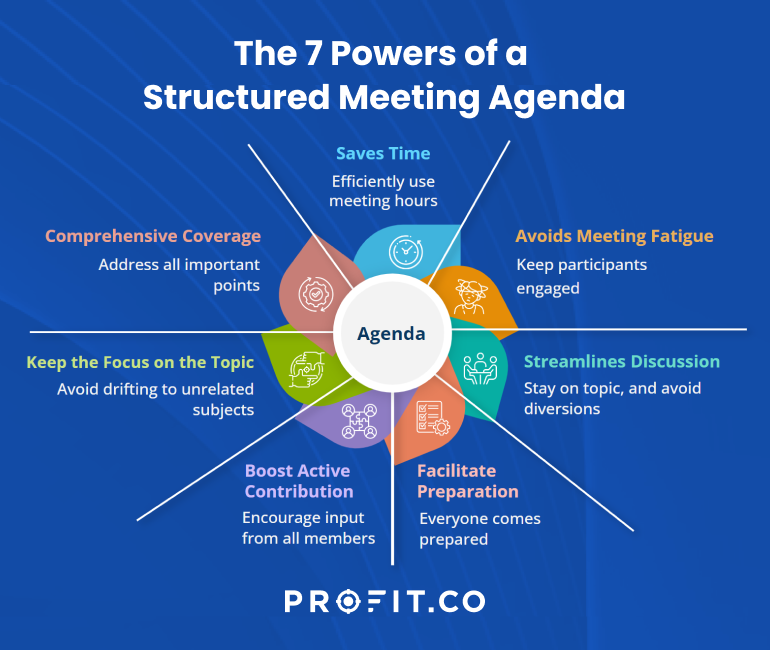Mastering the Art of Effective Meeting Agendas: A Practical Guide

Meetings can either drive progress or waste time, depending largely on how well they’re structured. A key tool for ensuring meetings are productive is a well-thought-out agenda. While it may seem like a simple task, creating an agenda that truly serves the meeting’s purpose takes some planning. Whether you’re leading a quick team check-in or a strategic planning session, a good agenda can be the difference between a productive meeting and one that feels like a time drain.
Here’s a step-by-step guide to crafting an agenda that keeps your meetings on track and your team focused.
1. Understand the Meeting’s Purpose

Before drafting an agenda, identify the primary goal of the meeting. Is it to solve a problem, share updates, or brainstorm ideas? Different types of meetings require different approaches. For instance, a brainstorming session may need more free-form discussion time, whereas a status update meeting might focus on efficiency and concise information sharing. Once you know the purpose, you’ll be able to structure the agenda to ensure the right outcomes are achieved.
Tip: Clearly communicate the meeting’s objective at the top of your agenda so everyone knows what to expect.
2. Divide the Agenda into Key Sections
A well-structured agenda typically includes four essential sections:
Logistics: This includes the meeting’s location (or virtual link), time, participants, and the type of meeting. Everyone needs to know where to be and why they’re attending.
Introduction: Give participants a chance to introduce themselves if necessary and briefly outline the goals of the meeting. This ensures everyone is on the same page from the start.
Content: This is the heart of the agenda. List the topics for discussion in a logical order, highlighting the key points to be addressed. Assign responsibility for each section, specifying who will lead the discussion or presentation.
Wrap-Up: Reserve time at the end to review the meeting’s decisions, outline next steps, and confirm action items and responsibilities.

This structure ensures the meeting flows smoothly, covering all critical points without rushing or losing focus.
3. Prioritize Key Topics
It’s tempting to cram as many items as possible into a meeting, but this often leads to rushed discussions and incomplete decision-making. Instead, prioritize two or three key topics and tackle the most important ones first. This allows for in-depth discussions and ensures that high-priority issues receive the attention they deserve.
Tip: If there are smaller issues that need addressing, consider handling them via email or a quick follow-up rather than dedicating precious meeting time to them.
4. Distribute the Agenda in Advance
An agenda is most effective when participants can review it ahead of time. This allows attendees to prepare and gather any necessary information for discussion. It also ensures that everyone arrives at the meeting with a clear understanding of what will be covered.
In some cases, sharing additional materials such as reports, data, or background information can help attendees arrive ready for meaningful discussion. The more informed participants are, the more focused and efficient the meeting will be.

5. Assign an Agenda-keeper
Designate someone to keep the meeting on track by monitoring the agenda. This person doesn’t need to be the meeting leader, but they should feel comfortable stepping in if the discussion starts to veer off course. A simple reminder about the meeting’s objectives can quickly refocus the conversation and keep things moving.
Tip: Visibly displaying the meeting goals can help serve as a gentle reminder to stay on topic.
6. Be Flexible but Stay Focused
Even with a well-structured agenda, unexpected issues may arise. When that happens, it’s important to be flexible while still maintaining focus. If a more pressing issue comes up mid-meeting, take a moment to get consensus from the group before shifting focus. This ensures that time is being spent on the most important issues without disregarding the original meeting goals.
7. Use the Agenda for Follow-Up

A well-constructed agenda can serve as a guide for post-meeting follow-up. At the end of the meeting, summarize decisions made, action items, and responsibilities. Distribute a copy of this summary to attendees as a reminder of their commitments and next steps. This not only reinforces accountability but also helps to maintain momentum until the next meeting.
Crafting an effective agenda takes some time and thought, but the benefits far outweigh the effort. A clear, structured agenda helps to minimize confusion, keeps discussions on track, and ensures that meetings are productive rather than wasteful. By implementing these strategies, you’ll create a roadmap for efficient and focused meetings that lead to real results.

























